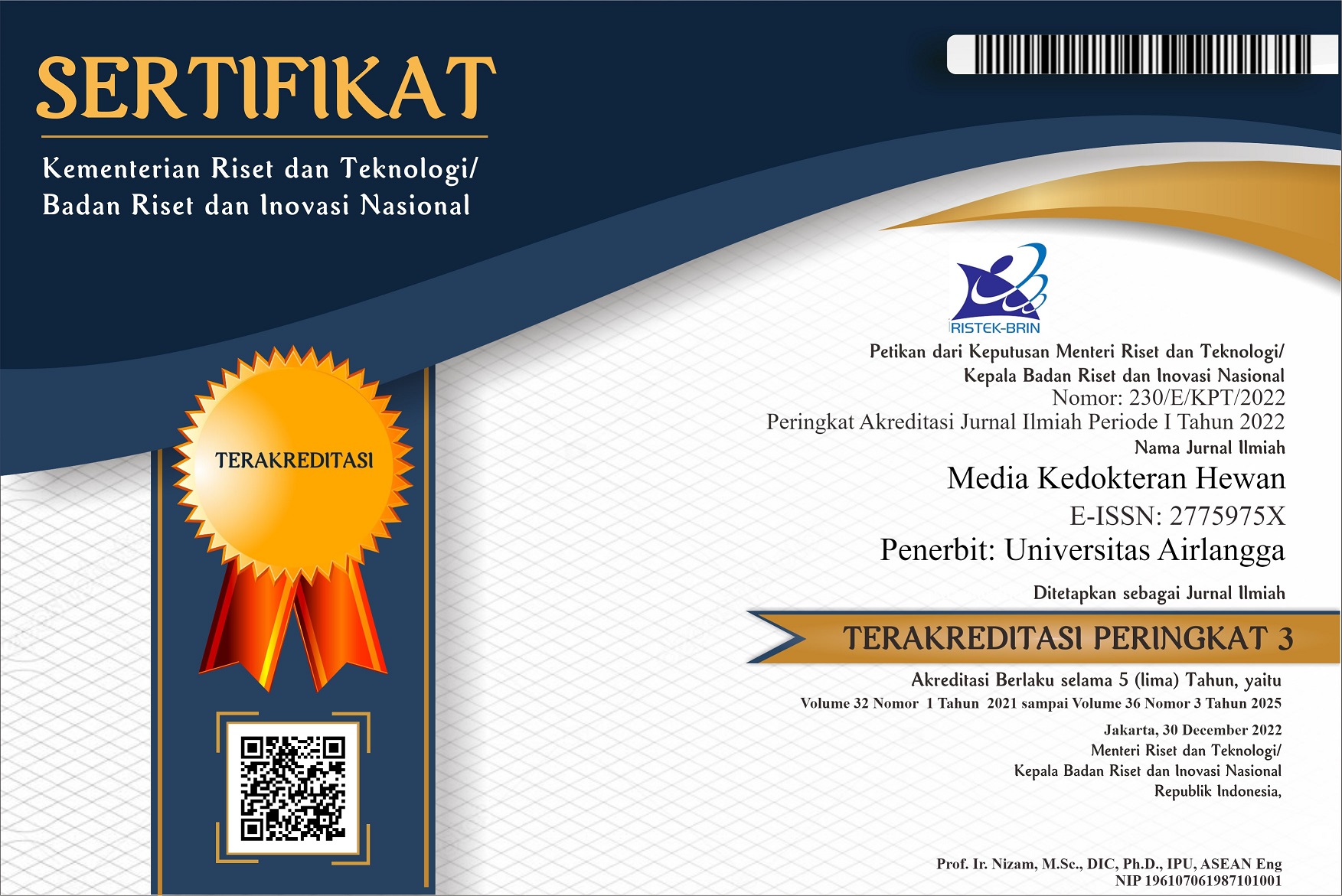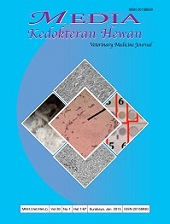Case Report: Therapeutic Management of Anaplasma spp. Infection in A Dog from Fiji Island
Downloads
Anaplasmosis is an emerging tick-borne zoonotic pathogen in dogs and humans that has recently gained attention in parasitology and microbiology study groups worldwide. This infection has been reported in regions worldwide. There are no reported cases of exposure to Anaplasma spp. canine or human patients in the Fiji Islands. This is the first reported case of canine Anaplasma spp. infectious canine cyclic thrombocytopenia in the Fiji Islands. Canine patients were presented to Pacific Animal Shelter and Hospital (PASH) in the Fiji Islands were screened for Anaplasma spp. antibodies using a commercial kit based on an enzyme-linked immune assay. Anaplasma spp. infection was diagnosed based on major clinical data, hematological findings and positive serology tests. The case was diagnosed as canine Anaplasmosis and was successfully treated with Doxycycline and other supportive treatments.
Ahmed, R., Kr Nath, M., and Barman, U., et al., 2021. A case report on therapeutic management of Anaplasma platys infection in a labrador. The Pharma Innovation Journal, 10(12), pp.1539-1541.
Arun, A., Reena, K.K., Rafiqui, S.I., Jithin, M. V, and Sharma, D.K., et al., 2017. Molecular and Parasitological Evidence of Anaplasma platys Infection in a Dog: A Case Report. Ann Clin Cytol Pathol., 3 (3), 1059. DOI: https://doi.org/10.47739/2475-9430/1059
Atif, F.A., Mehnaz, S., Qamar, M.F., Roheen, T., Sajid, M.S., Ehtisham-Ul-haque, S., Kashif, M., Ben Said, M., 2021. Epidemiology, diagnosis, and control of canine infectious cyclic thrombocytopenia and granulocytic Anaplasmosis: Emerging diseases of veterinary and public health significance. Veterinary Sciences, 8(12), 312. DOI: 10.3390/vetsci8120312
Balmori-de la Puente, A., Rodríguez-Escolar, I., Collado-Cuadrado, M., Infante González-Mohino, E., Vieira Lista, M.C., Hernández-Lambraño, R.E., Sánchez-Agudo, J.Á., and Morchón, R., 2024. Transmission risk of vector-borne bacterial diseases (Anaplasma spp. and Ehrlichia canis) in Spain and Portugal. BMC Veterinary Research, 20 (1), 526. DOI: 10.1186/s12917-024-04383-3
Carvalho, L., Armua-Fernandez, M.T., Sosa, N., Félix, M.L., and Venzal, J.M., 2017. Anaplasma platys in dogs from Uruguay. Ticks and Tick-borne Diseases, 8 (2), pp.241–245. DOI: https://doi.org/10.1016/j.ttbdis.2016.11.005
Das, C., Sarma, K., Eregowda, C. G., Roychoudhury, P., Bhowmik, A., and Rajesh, J. B., 2024. Clinico-pathological and Molecular Findings in Canine Anaplasma phagocytophilum Infection and its Therapeutic Management. Ind J Vet Sci Biotech., 20(3), pp.171-175. DOI: http://dx.doi.org/10.48165/ijvsbt.20.3.34
Elhamiani Khatat, S., Daminet, S., Kachani, M., Leutenegger, C.M., Duchateau, L., El Amri, H., Hing, M., Azrib, R., and Sahibi, H., 2017. Anaplasma spp. in dogs and owners in north-western Morocco. Parasite Vectors, 10 (1), 202. DOI: 10.1186/s13071-017-2148-y
El Hamiani Khatat, S., Daminet, S., Duchateau, L., Elhachimi, L., Kachani, M., and Sahibi, H., 2021. Epidemiological and Clinicopathological Features of Anaplasma phagocytophilum Infection in Dogs: A Systematic Review. Front Vet Sci., 23(8), 686644. DOI: 10.3389/fvets.2021.686644
El Hamiani Khatat, S., Kachani, M., Duchateau, L., Elhachimi, L., Sahibi, H., and Daminet, S., 2022. Anaplasma spp. in dogs: Is there a danger for humans? Revue Veterinaire Clinique, 57(1), pp. 1-15. DOI: https://doi.org/10.1016/j.anicom.2021.10.001
Facile, V., Sabetti, M.C., Balboni, A., Urbani, L., Tirolo, A., Magliocca, M., Lunetta, F., Dondi, F., and Battilani, M., 2024. Detection of Anaplasma spp. and Ehrlichia spp. in dogs from a veterinary teaching hospital in Italy: a retrospective study 2012–2020. Veterinary Research Communications, 48 (3), pp.1727–1740. DOI: https://doi.org/10.1007/s11259-024-10358-4
Fan, Q.H., 2024. An annotated catalogue of mites and ticks (Acari) in Fiji. Zootaxa, 5486 (3), pp.351–387. DOI: https://doi.org/10.11646/zootaxa.5486.3.3
Hamidinejat, H., Bahrami, S., Mosalanejad, B., and Pahlavan, S., 2019. First Molecular Survey on Anaplasma phagocytophilum Revealed High Prevalence in Rural Dogs from Khuzestan Province, Iran. Iranian Journal of Parasitology, 14(2), pp. 297-302.
Kohn, B., Galke, D., Beelitz, P., and Pfister, K., 2008. Clinical features of canine granulocytic Anaplasmosis in 18 naturally infected dogs. Journal of Veterinary Internal Medicine, 22 (6), pp.1289–1295. DOI: https://doi.org/10.1111/j.1939-1676.2008.0180.x
López-Valencia, G., Meza-Silva, K.M., Haro-Álvarez, A.P., Trasviña-Muñoz, E., Garcia-Reynoso, I.C., Herrera-Ramírez, J.C., and Gómez-Gómez, S.D., 2024. Prevalence, risk factors, and hematologic changes in dogs from Baja California with presence of Ehrlichia spp., and co-infection with Anaplasma spp. Austral Journal of Veterinary Sciences, 56(2), pp.75–84. DOI: https://doi.org/10.4206/ajvs.562.06
Martinescu, G.V., Ivănescu, L., Ștefănescu, R., Andronic, L., Mătiuț, S., Mîndru, R., Solcan, G., and Miron, L., 2024. Strategies for the Diagnosis of Granulocytic Anaplasmosis in Two Naturally Infected Dogs. Animals, 14 (1), 49. DOI: https://doi.org/10.3390/ani14010049
Matei, I.A., Estrada-Peña, A., Cutler, S.J., Vayssier-Taussat, M., Varela-Castro, L., Potkonjak, A., Zeller, H., and Mihalca, A.D., 2019. A review on the eco-epidemiology and clinical management of human granulocytic Anaplasmosis and its agent in Europe. Parasites Vectors, 12, 599. DOI: https://doi.org/10.1186/s13071-019-3852-6
Oliveira, A.D.S., Graboschii, A.C.G., Silva, K. de O. e., Melo, M., Bittencourt, T.C.B. dos S.C. de, and Escodro, P.B., 2024. Seroprevalence of anti-Ehrlichia sp. and Anaplasma sp. antibodies in dogs sheltered in 2022 in Maceió, Alagoas. Brazilian Journal of Veterinary Research and Animal Science, 61(special issue), e218095. DOI: http://dx.doi.org/10.11606/issn.1678-4456.bjvras.2024.218095
Payandeh, M., Yahyaei, F., Nasrollahi, P., Heydarnejad, O., Zarrin, K. and Abdous, A., 2025. Prevalence of Anaplasmosis in Dogs of Alborz Province from 2021 to 2023. Paper presented at the 4th National Congress of Companion Animal Medicine, March 2025.
Sainz, Á., Roura, X., Miró, G., Estrada-Peña, A., Kohn, B., Harrus, S., and Solano-Gallego, L., 2015. Guideline for veterinary practitioners on canine ehrlichiosis and Anaplasmosis in Europe. Parasite Vectors, 8, 75. DOI: 10.1186/s13071-015-0649-0
Situmorang, F.J.I.C., Suartha, I.N., and Jayanti, P.D., 2024. A Case Report: Treatment of Anaplasmosis and Ectoparasitic Infestation in Mixed-Breed Golden Retriever Dog. Media Kedokteran Hewan, 35 (3), pp.281–293.
Soni, A. K and Shrivastava, N., 2022. Anaplasmosis in a Dog. International Journal of Agriculture Sciences, 14 (5), pp.11292–11293.
Springer, A., Montenegro, V.M., Schicht, S., Vrohvec, M.G., Pantchev, N., Balzer, J., and Strube, C., 2019. Seroprevalence and current infections of canine vector-borne diseases in Costa Rica. Frontiers in Veterinary Science, 6,164. DOI: 10.3389/fvets.2019.00164
Thounaojam, R., Rajesh, J.B., Momin, S.G., Sangma, J.D., Marak, S.S., 2023. Detection of Anaplasma antibodies through SNAP4Dx plus and therapeutic management of canine Anaplasmosis.The Pharma Innovation Journal, 12(10), pp.943-945.
Widyasanti, N.W.H., Putra, I.P.C., and Suwiti, N.K., 2025. Case Report: Ehrlichiosis and Anaplasmosis in Timber Wolf Crossbreed (Canis lupus) in Bali, Indonesia. Media Kedokteran Hewan, 36 (1), pp.88–99. DOI: https://doi.org/10.20473/mkh.v36i1.2025.88-99
Wijeratne, H.S.U. and Perera, S.V.N., 2022. Anaplasmosis in dogs in the western province of Sri Lanka: seroprevalence, clinical and laboratory findings. Sri Lanka Veterinary Journal, 69 (1), pp.17–23. DOI: http://dx.doi.org/10.4038/slvj.v69i1.57
Copyright (c) 2025 prashanth yogeswaranthan

This work is licensed under a Creative Commons Attribution-ShareAlike 4.0 International License.

Veterinary Medicine Journal by Unair is licensed under a Creative Commons Attribution-ShareAlike 4.0 International License.
1. The Journal allows the author to hold the copyright of the article without restrictions.
2. The Journal allows the author(s) to retain publishing rights without restrictions
3. The legal formal aspect of journal publication accessibility refers to Creative Commons Attribution Share-Alike (CC BY-SA).





11.jpg)







11.png)













